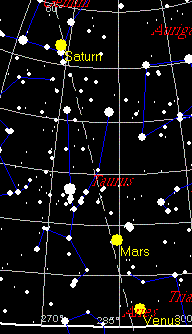
| |
 |
 Note in the description below from someone not checking the expected positions of the planets in a planetarium program such as
SkyMap, but reporting just what they see, there is no mention of Mars, but less visible planets such as Saturn and Jupiter are
mentioned. This is because Mars has moved along rapidly in its orbit, while Earth stalled, and Mars thus rises early, as it did for the
Conjunction on Feb 25.
Note in the description below from someone not checking the expected positions of the planets in a planetarium program such as
SkyMap, but reporting just what they see, there is no mention of Mars, but less visible planets such as Saturn and Jupiter are
mentioned. This is because Mars has moved along rapidly in its orbit, while Earth stalled, and Mars thus rises early, as it did for the
Conjunction on Feb 25.
I have been observing the movement of Venus here from a more SW direction just 2 weeks ago to a much more NW direction now. It's 9:30 CST here in Louisiana this evening and Venus is still visible over the NW horizon. I do not recall a time when this planet remained visible over the horizon with such magnitude this late into the evening.
Per Skymap for a Mar 17 position, Venus should be at at 285° where the Ecliptic touches the horizon, barely north of West, but in a halted Earth orbit in a Dec 25 orbit with a strong tilt and lean to the East, the Ecliptic would angle in sharply from left to right, thus Venus on the Ecliptic behind the Earth would appear in the NW.
Jupiter, on the other hand is visible high overhead and almost in alignment with Venus.
Per Skymap for a Mar 17 position, Jupiter should be up and over the dome from a 285° position for Venus and 35° down the other side, in other word, to the East! But in a halted Earth orbit in a Dec 25 position with a strong tilt toward the Sun and lean toward the East, Jupiter would appear more overhead.
Saturn is visible to the South and well below the position of Jupiter.
Per Skymap, Saturn should be at 270° West and 50° above the horizon, not South! But in a halted Earth orbit in a Dec 25 position with a strong tilt in toward the Sun, Saturn would appear more to the South, and as the Earth had not moved along as expected in its orbit, the view toward Saturn is not to the West.